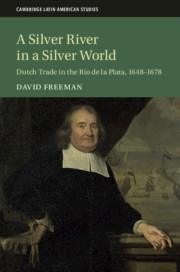Book contents
- A Silver River in a Silver World
- Cambridge Latin American Studies
- A Silver River in a Silver World
- Copyright page
- Dedication
- Contents
- Acknowledgments
- Maps
- Introduction
- 1 The Silver World
- 2 The Silver River
- 3 Golden Connections
- 4 Dutch Ships and Dutch Men on the Río de la Plata
- 5 Conflicting Ownership
- 6 Silver Tongues
- 7 Silver Politics on the Estuary
- 8 The Silver River Runs Dry
- Bibliography
- Index
- Series list continued from page ii
Introduction
Published online by Cambridge University Press: 18 April 2020
- A Silver River in a Silver World
- Cambridge Latin American Studies
- A Silver River in a Silver World
- Copyright page
- Dedication
- Contents
- Acknowledgments
- Maps
- Introduction
- 1 The Silver World
- 2 The Silver River
- 3 Golden Connections
- 4 Dutch Ships and Dutch Men on the Río de la Plata
- 5 Conflicting Ownership
- 6 Silver Tongues
- 7 Silver Politics on the Estuary
- 8 The Silver River Runs Dry
- Bibliography
- Index
- Series list continued from page ii
Summary
As the sun rose over the Río de la Plata on 3 April 1660, Albert Jansen could look out over the river and see two of his ships at anchor. The Goude Leeuw, just arrived from Amsterdam, was carrying merchandise destined not only for Buenos Aires, but also inland as far as Potosí. His other ship, the Vergulde Valk, had been in Buenos Aires for several months and would shortly depart the city for the return journey to Amsterdam. At age thirty, Jansen had already made a small fortune importing textiles, hardware, and other merchandise from Amsterdam to Buenos Aires and exporting hides and, especially, silver. Silver was the primary reason Jansen, and other Dutch merchants like him, were in the Río de la Plata. Buenos Aires itself was not a very large market. However, Potosí, with its thriving population, commercial economy, and silver mines, was just two months overland by pack mule and cart. The Spanish trading route to Potosí went the other way, via Lima to the west coast of South America and from there north to the Caribbean and beyond to Seville or Cádiz. Buenos Aires offered merchants a much more direct route, but there was the problem of accessing it as the port was officially closed to unauthorized shipping.
- Type
- Chapter
- Information
- A Silver River in a Silver WorldDutch Trade in the Rio de la Plata, 1648–1678, pp. 1 - 10Publisher: Cambridge University PressPrint publication year: 2020

